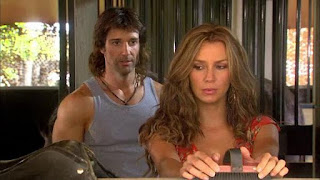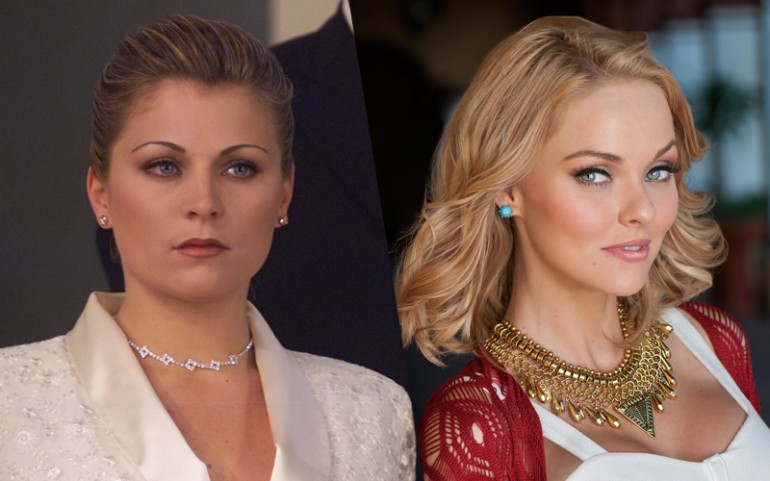To Be or Not to Be (a Cinderella)
Something I’ve noticed as I work my way through the first episodes of Telemundo’s El fantasma de Elena is the presence of Cinderella-esque qualities in the two protagonists: Elena and Eduardo. We have discussed in-depth the Cinderella archetype as it pertains to the female protagonists in many telenovelas around the world. We have also learned that there are variations in this archetype – specifically the type where the man is the Cinderella.
My telenovela differs from these
two journeys as both protagonists display qualities of the Cinderella archetype
where both the male and the female protagonists have some Cinderella-like
characteristics, but it could not be said that either character is a Cinderella
through and through.
 |
| The two main protagonists, Elena and Eduardo, having their first real conversation. (Image from Hulu) |
Elena is a woman in her mid- to late twenties who had only ever been in one relationship prior to meeting Eduardo. One could say she is at least romantically naïve as her previous partner, Octavio, had been in her life since her childhood. The beginning plot also highlighted a special bond Elena has with animals, particularly with her horse Gitano. She exhibits so much kindness to her own horse, but also the white horse she saw right before she met Eduardo (very symbolic, no?). This gentle and caring touch is exhibited towards humans as well. After following the white horse through the woods, trying to help, she stumbled upon Eduardo, who was injured. Without hesitation, she dragged him into her truck amid a hurricane and took him to her family’s hotel located in Key West.
Though these qualities all make up a conventional
Cinderella, Elena lacks some of the essential qualities of this character.
Unlike the beloved fairytale, Elena has a great relationship with her family,
including her stepmother, Mariela. Mariela is opposite of the “evil” stepmother
personality that many Cinderella stories contain. Elena also did not have a
poor upbringing. So far, it has never been mentioned that she was a maid or a
servant in any way. In fact, she is a professional horseback rider, implying
that her family has at least some wealth, as most lower and middle class people
do not have the means to spend on this luxurious hobby.
On the other hand, Eduardo displays some of his own Cinderella
qualities too. Like Elena, Eduardo shares a similar kind disposition towards
animals. He owns a large horse ranch where they train horses to compete in
polo, horse racing, and other related activities. He easily calmed Elena’s
horse Gitano while the hurricane raged around them in Elena’s family’s stable. However,
unlike Elena, Eduardo’s parents are not in the picture, and in one episode,
Eduardo’s older brother Dario implied that he raised Eduardo. Eduardo also has a half-brother
named Monte Cristo (yes, that is his actual name), and even though he is not a stepsibling,
he is currently creating chaos for his brothers’ family business. While the
setting of Eduardo’s ranch is picturesque – a huge mansion with lots of lush
green pasture – the viewer learns in the fifth episode that the family business
is in a decline. Eduardo and Dario used Dario’s wife and sister-in-law’s
inheritance to keep the business running. Eduardo would be poor if he were to
try and stand alone financially.
Nonetheless, like Elena, Eduardo also has
characteristics that inhibit him from completely fulfilling the Cinderella role
in the telenovela. First, he is not a woman. He is, in my opinion, an over-the-top
macho man. He is also not a conventionally kind person. The only person he
seems to be kind to is Elena. He has made threats to his sister-in-law and
bickers with Dario in many scenes. Finally, while Eduardo is poor without the
financial support of his in-laws, he is in no way a maid or has lower class job.
He does still live comfortable in a mansion on a large plot of land with his
whole family and servants of his own.
All in all, I found this comparison between my
telenovela and the content we have gone over in class very interesting. It
proves that even variations in the Cinderella story have their own variations.
It also further underscores the realist element of this telenovela. While there
is a paranormal element and lots of mystery (and potentially witchcraft), I
think the fact that the two protagonists are imperfect creates a balance
between the real and nonreal elements present in this show.
I think it will be entertaining to see these characters
develop throughout the show and see if these archetypal roles change or
diminish over time. I am intrigued to learn if Elena changes at all based on
Eduardo’s new influence in their lives as a married couple, or if his family
affects her kind demeanor. They could take the place of Cinderella’s stepfamily
in the archetypal role. When I last left them, she had just been introduced as
Eduardo’s wife to his family, unbeknownst to them that he had even gotten
married in the week he spent away from them. No one took the news very well,
and the maids are concerned for Elena’s wellbeing, predicting that the family
will destroy her.

Hi Rose! I like your analysis of the male Cinderella, especially because you add a layer of nuance for both Elena and Eduardo. I grew up watching a series of very realistic telenovelas, so reading your article, I had a question: if they both share characteristics of a Cinderella (at least towards each other), do they ever face challenges in their relationship that are not imposed on them from the outside? For example, do they self-sabotage or cause pain to each other directly? I was wondering because there is still a lot of stigma about the Cinderella character as being Pollyanna-ish, and even though you said they're not, you did mention that Eduardo's still kind to Elena. And if they do cause pain to each other, is it because of a negative action (like, lying or cheating) or is it a consequence of their goodness (they're good to a fault)?
ReplyDeleteReading this blog after we've discussed non-stereotypical cinderella stories in class was very interesting.
ReplyDeleteI can clearly see what you meant about Elena and Eduardo resembling, but not perfectly encapsulating a Cinderella love story.
It is very interesting how two characters may have richer families (though Eduardo's may be failing), yet their differences seem to reign over similarities. This, I suppose, is a greater example of a Cinderella-story quality as their differing personalities and families are more-so highlighted than their properties/land.
It is also very neat how Elena has a bond with animals, as Cinderella does with her mice and birds, yet Elena's are more noble; I suppose representing how she herself is definitively of a higher status than one's simple classic cinderella.
It seems as though Eduardo, while poor-mannered, is not foolish or naïve, instead, being knowledgeable of what he wants and he too has the special connection with animals. In a way it seems as though the story displays Eduardo and Elena as both Cinderellas and Prince Charmings, in need of each other to be whole/better.
The introduction of the paranormal into the show further redefines how the show may differ from a classic cinderella story, ironic, however, considering Cinderella herself had a magical fairy godmother.
Your blog, much like an actual telenovela, ends on a cliff hanger and has me wanting to watch the show more to see how it ends or what the maids are so concerned about with Elena.
Overall the show seems very intriguing and boundary-breaking as far as rosa-telenovelas are concerned. Considering it has already broken the stereotypes of the roles and their status', it is interesting to imagine what else may vary in its classic story telling. Whether Elena and Eduardo even end up together at all, or if Eduardo turns out to be evil, or if there is another protagonist who may change up the roles; all remain unknown, but possibilties of an already unpredictable telenovela.
It is refreshing to see one change up the narrative and recognize that a woman can be strong and independent and successful, or have a positive relationship with her family, while also showing that a macho-man may not always be the right representation and that there are faults to this sort of person that run deeper than what may appear.